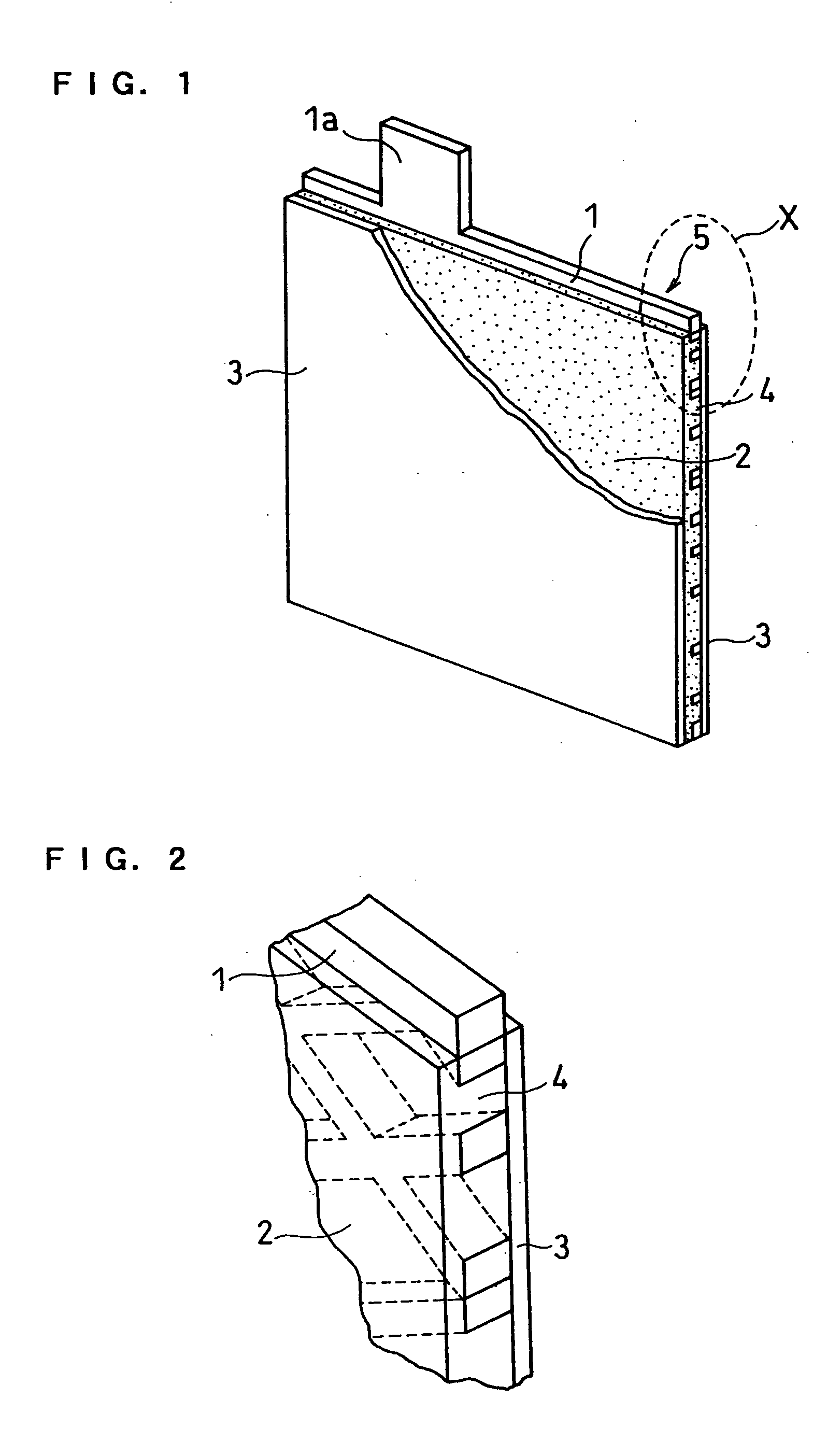Lead storage battery
a technology of lead storage and lead acid, which is applied in the direction of cell components, sustainable manufacturing/processing, and final product manufacturing, etc., can solve the problems of difficult formation of a frame around the electrode, short circuit between the positive and negative electrodes, and the active material at these portions of the electrode is likely to separate from the electrode, so as to achieve superior acid resistance, prevent the separation of active materials, and improve the effect of resistan
- Summary
- Abstract
- Description
- Claims
- Application Information
AI Technical Summary
Benefits of technology
Problems solved by technology
Method used
Image
Examples
example 2
[0074] A sealed lead-acid battery with a rated voltage of 12 V and a nominal capacity of 65 Ah was produced in the same manner as in Example 1, except that the organic binder was impregnated in the active material layer at the right and left edge portions of the positive electrode using the same method as in Example 1, instead of the negative electrode. The battery was referred to as Battery B.
example 3
[0083] FIG. 6 shows a transverse sectional view of a relevant part of the lead-acid battery of the present example.
[0084] After a negative electrode 5 was produced in the same manner as in Example 1, a porous resin layer 10 having through holes was formed on the surface of an active material layer 2 at the right and left edge portions 4 of the negative electrode 5 by the following process.
[0085] Butyl rubber and styrene rubber were mixed at a weight ratio of 97:3. A resin solution was prepared by dissolving 30 parts by weight of the obtained mixed resin in 70 parts by weight of toluene. In the resin solution was dispersed azodicarbonamide as a foaming agent, and the right and left edge portions of the negative electrode 5 were respectively impregnated with the dispersion. Subsequently, it was foamed at 210% and, at the same time, toluene as the solvent was removed therefrom. During this process, part of the resin component permeated the periphery of the surface of the active materia...
example 4
[0087] A sealed lead-acid battery with a rated voltage of 12 V and a nominal capacity of 65 Ah was obtained in the same manner as in Example 3, except that the porous resin layer having through holes was formed on the surface of the active material at the right and left edge portions of the positive electrode using the same method as in Example 3, instead of the negative electrode. The battery was referred to as Battery F.
[0088] Batteries E and F were put through the same cycle life evaluation as in Example 1. FIG. 7 shows the evaluation results. It also shows the results of Batteries C and D for comparison.
[0089] FIG. 7 indicated that Batteries E and F respectively maintained a capacity of over 90% of the initial discharge capacity even after 800 cycles. (Batteries E and F had an initial discharge capacity of 61.0 and 60.0 Ah respectively and a discharge capacity after 800 cycles of 55.0 and 54.0 Ah respectively). Batteries E and F were disassembled in the same manner as in Example...
PUM
| Property | Measurement | Unit |
|---|---|---|
| Electrical resistance | aaaaa | aaaaa |
Abstract
Description
Claims
Application Information
 Login to View More
Login to View More - R&D
- Intellectual Property
- Life Sciences
- Materials
- Tech Scout
- Unparalleled Data Quality
- Higher Quality Content
- 60% Fewer Hallucinations
Browse by: Latest US Patents, China's latest patents, Technical Efficacy Thesaurus, Application Domain, Technology Topic, Popular Technical Reports.
© 2025 PatSnap. All rights reserved.Legal|Privacy policy|Modern Slavery Act Transparency Statement|Sitemap|About US| Contact US: help@patsnap.com



